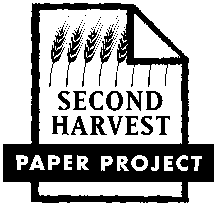
Second Harvest Paper Project
Tree Free Paper Out of the Boutique and into the Mainstream
 For
the latter part of this century North America has been underutilizing
agricultural fibres (wheat, flax, rye, rice, hemp straw, etc) for the
manufacture of papers. This has put the burden of supplying a dramatic
increase in paper consumption on forests and has impacted farmers’
income potential from their crops. Currently millions of acres of straw
in North America are being burned or dumped. In the prairie provinces
of Canada where logging companies are cutting endangered old growth forest
for paper, the straw left after harvest could produce more pulp than there
is current mill capacity to produce! For
the latter part of this century North America has been underutilizing
agricultural fibres (wheat, flax, rye, rice, hemp straw, etc) for the
manufacture of papers. This has put the burden of supplying a dramatic
increase in paper consumption on forests and has impacted farmers’
income potential from their crops. Currently millions of acres of straw
in North America are being burned or dumped. In the prairie provinces
of Canada where logging companies are cutting endangered old growth forest
for paper, the straw left after harvest could produce more pulp than there
is current mill capacity to produce!
Second
Harvest Paper Project joins the skills and experience of three organizations,
Fiber Futures, ForestEthics and Markets Initiative, to build mainstream
market demand for paper made with agricultural fibres. We are leveraging
that demand to encourage pulp mills to invest in non-wood pulp mill infrastructure.
Second
Harvest Paper Project is organized to work with the pulp and paper industry
to diversify their raw fibre base, as part of our forest conservation
goals, and to support the development of mill technology that is more
energy, water and chemical efficient. In the process farmers find new
markets, and mills pulp significantly fewer old growth and endangered
forests. Straw burning, deforestation and pulping trees are bad for climate
change. Switching to agricultural fibres for paper reduces greenhouse
gas emissions, helps conserve endangered forests and stimulates rural
economic development. We’re building the market demand for a better
supply of paper.
|



